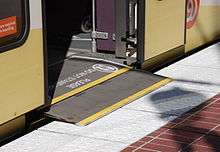Bridge plate

A bridge plate is a mechanical, movable form of wheelchair ramp that is used on some low-floor light rail vehicles to provide for wheelchair access. The bridge plate extends from the vehicle to the platform, which must be raised to close to the level of the floor of the vehicle so that the wheelchair need not travel over an excessively steep ramp (in the United States, the Americans with Disabilities Act specifies that the slope must be no more than 1 inch of rise for every 12 inches of length). Some low-floor buses also use bridge plates (in this case, extending to the curb) to provide for wheelchair access, but many low-floor buses instead use a ramp that normally serves as part of the floor but can be flipped out through the door (using a hinge at the door) onto the curb or street; in this case the ramp is long enough that it can serve as a true wheelchair ramp rather than a bridge without being excessively steep.
Bridge Plate may also refer to markings used on Allied vehicles beginning in World War II that indicates the weight of the vehicle in tons as well as the weight classification of the vehicle. This was used to calculate whether a vehicle, or series of vehicles, could safely cross a bridge with a given rating.
While originally designed by the British as an affixed metal plate that was yellow in color, later in the war (and afterwards) it was commonplace to simply paint the number onto a vehicle whose weight was unlikely to change.
While simple in idea, the actual classification is complicated by being based not only on gross vehicle weight, but on whether the vehicle is wheeled or tracked, the number of axles, axle spacing, vehicle speed, the number of lanes the vehicle uses and whether or not the vehicle could be hauling a trailer.
These markings (or plates) were typically found on the right front fender or in the area of the right front headlamp.
Source: US Army Technical Manual TM 9-2320-209-10-1]